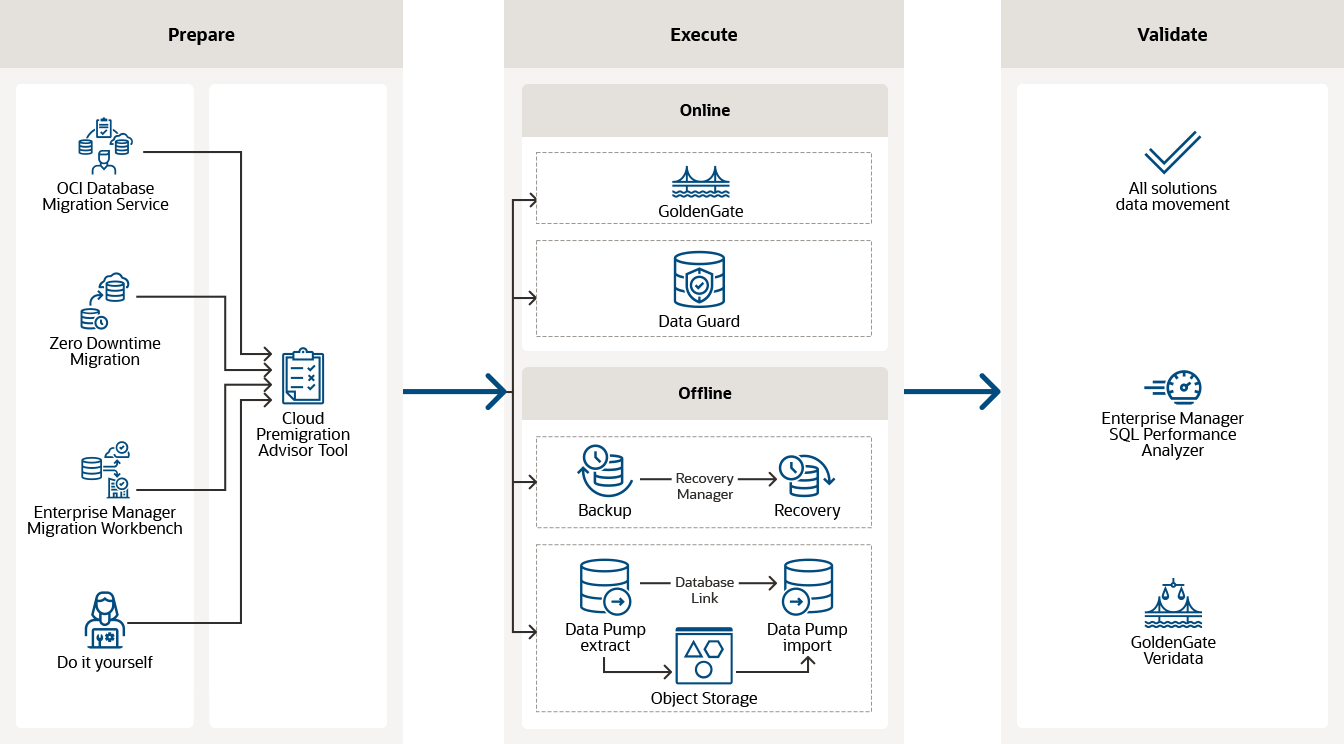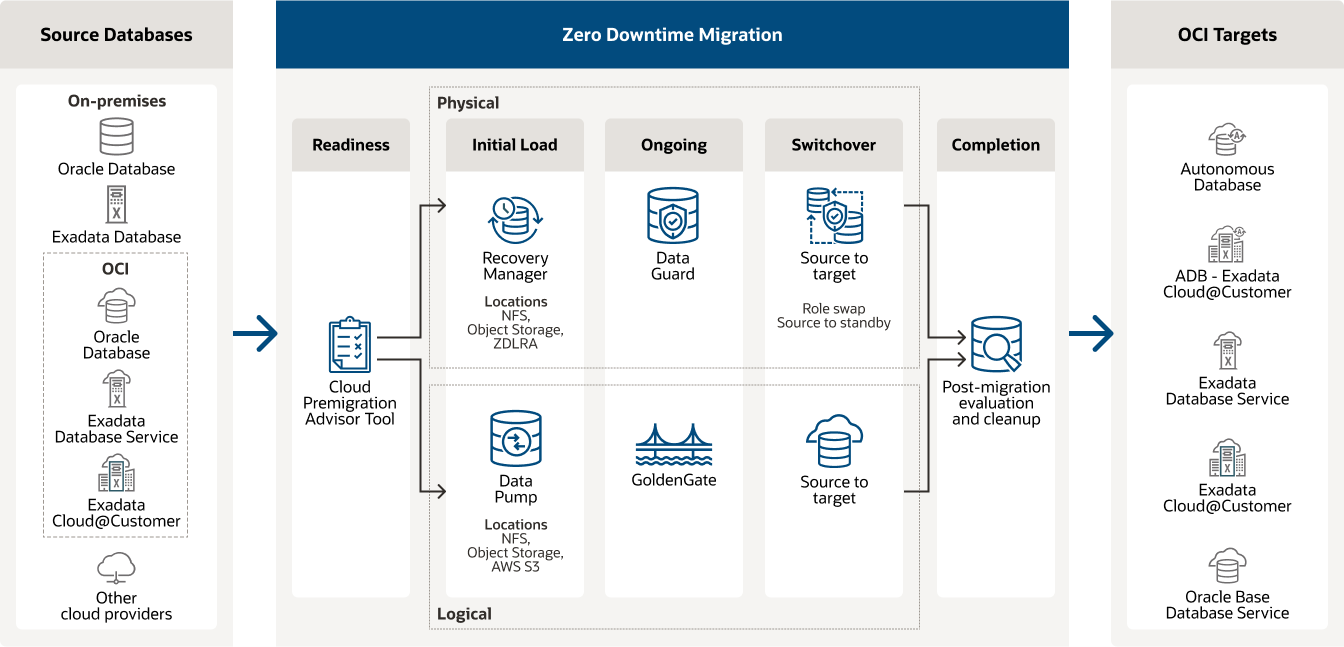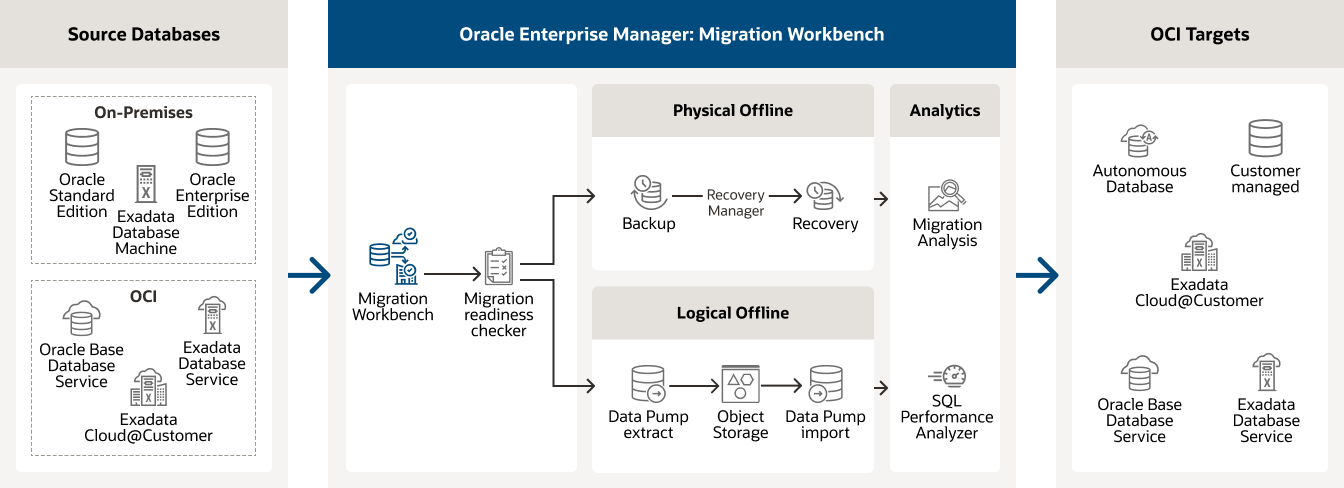Migrate Oracle Databases to OCI
Oracle provides strategies, solutions, tools, and services for online and offline database migrations. Free planning advisors, automation, and step-by-step guides help you perform non-disruptive and validated migrations.
Featured migration programs
Migrate Oracle Databases to OCI
-
Maintain business uptime
Migrate databases while applications are online.
-
Every version and platform
Move from any version, platform, and OS to any OCI Database service, including Exadata, Cloud@Customer, and Autonomous.
-
Extensive automation
Choose easy-to-use user experiences that simplify even the most complex scenarios or assemble workflows for exceptional situations.
-
Much more than moving data
Advisors help you choose target databases, efficient estate migration, and best practice methods.
-
Upgrade as you migrate
Upgrade and migrate simultaneously in a streamlined migration workflow.
-
Leverage existing investments
Transfer licenses and workloads with BYOL for discounted rates, support fee offsets, and more.
Getting Started: Migrate Oracle Databases to OCI
Overview
Oracle’s best practice planning advisors and automated solutions help you through your migration lifecycle. Supported by zero downtime technologies and enterprise-class database utilities, applications can remain online during migrations, enabling the least risk, disruption, and cost.

| Plan | Prepare | Execute | Validate |
|---|---|---|---|
|
|
|
|
Planning Advisors
Best practice planning tools allow you to make strategic and tactical decisions, from choosing the best database to migrating with the least effort and business disruption. Fine-tune a migration method that considers acceptable downtime, upgrade considerations, and DBA skills.

Oracle offer six database migration planning advisors. Each of these tools can be used independently or together to help you assess your database migration options, strategy, and complexity. They are grouped into two categories: overall estate assessment and specific technical recommendations. Some tools require little to no preparation and others require complete details of your database estate. If you choose TRY, you can try out these tools.
Here’s brief summary for each of these tools:
Estate Explorer evaluates an entire database estate that you can upload from a spreadsheet or Enterprise Manager. The reporting identify database candidates that require the least effort to migrate to Autonomous Database.
Service Advisor helps you choose which Oracle Database service is best for your requirements.
Methods Advisor provides quick insight to which migration method and supporting technologies are appropriate for specific source and target databases.
Premigration Tool is a detailed technical diagnostic tool that identifies incompatibilities and remediation for upgrades and migrations between databases.
Cloud Migration Advisor is a detailed diagnostics and recommendation tool combining the capabilities of the migration methods advisor and estate explorer plus additional factors to make more precise recommendations.
Enterprise Manager Migration Workbench is an embedded feature of Enterprise Manager. This tool leverages known metadata around your database estate and makes planning recommendations.
Two of these tools, Estate Explorer and Cloud Migration advisor are not yet self-service, but with the help of your Oracle sales person, you can access them. Enterprise Manager is a licensed product, but you can explore the product on a trial basis from within the OCI Marketplace.
You can learn more about these tools and access informative links on the TECHNOLOGIES tab.
Prepare
Evaluate source databases with the Cloud Premigration Advisor Tool (CPAT) against target database and platform to identify upgrades, prioritize exceptions, and suggest resolutions. Use step-by-step guides to provision environments and iteratively test migration workflows.

In this "Prepare" diagram, there are two layers of preparation steps. The first layer above represents the Cloud Premigration Advisor Tool (CPAT). These are the steps to evaluate and prepare your source databases to be compatible with the target. The steps of CPAT are to identify exceptions, present the findings, take remediation actions or not, then rerun the advisor until all issues are resolved. CPAT is embedded into the automated migration solutions and part of the logical migration method workflows.
The second layer is to perform a test migration. These steps include provisioning cloud resources, run or execute the migration, validate the movement and performance, then reset the environment until you are ready to do execute the migration. PREPARATION means practice running the migration and developing procedures for failure, reset, and recovery.
Migration workflow technologies
Three automated alternatives streamline and orchestrate migration workflows using Oracle Database utilities for offline migrations. For online migrations, high availability and standby capabilities are added. Finally, additional technologies validate performance and ongoing synchronization.

In this EXECUTE diagram, all Oracle technologies are identified in each of the migration steps.
In the prepare phase, there are two strategies – use automated solutions or do it yourself with any of the component tools, services, utilities, and products. Regardless of your choice, the next step is to use the Cloud Premigration Advisor Tool to test the source database metadata and data against the compatibility requirements of the target database.
In the execute phase, there are two business continuity factors to choose from – online or offline. If you choose offline migrations, they can either by physical or logical. Physical means that you use the Oracle Recovery Manager backup-restore function. Logical means you use oracle Data Pump to do a data extract and import. If you choose online migrations, you will either use GoldenGate or Data Guard for the ongoing synchronization as new and changed data is introduced during the migration.
In the validate phase, all migration methods will validate that data moved. In addition to that, the Enterprise Manager solution also includes SQL Performance Analyzer in the workflow which will compare the performance of key SQL statements on both the original and migrated database.
Oracle GoldenGate Veridata validates that source and target databases are in sync. This is especially important during long migrations or in a complicated database implementation where multiple databases must stay in sync incrementally even during the migration.
Validate
Beyond ensuring data movement, SQL Performance Analyzer can prove operational readiness by comparing source versus target performance. For complex online migrations, Oracle GoldenGate Veridata guarantees that sources and targets are synchronized. GoldenGate Veridata and Enterprise Manager may require additional licensing.
-
![]()
Migration workflow solutions
- OCI Database Migration
- Zero Downtime Migration
- Enterprise Manager Migration Workbench
All solutions validate data and data object movement.
-
![]()
Enterprise Manager SQL Performance Analyzer
Ensures the target database performs better than the source. Part of Oracle Real Application Testing.
-
![]()
GoldenGate Veridata
Ensures that source and targets are synchronized.
Free migration methods and guides
- Overview
- Migration workflows
- OCI Database Migration
- Zero Downtime Migration
- Oracle Enterprise Manager
- Database utilities
Selecting a migration method
The best migration method considers business and technical planning factors. Oracle offers automated solutions that simplify and streamline upgrade and migration workflows using embedded Oracle utilities, Database options, and supporting products. DBAs can also use Oracle Database utilities to custom engineer their own migration workflows.

This OVERVIEW diagram describes the primary elements in selecting a migration method and its business and technical planning factors. The result of this planning exercise leads you to either automated or do it yourself migration execution. The migration methods advisor and the cloud migration advisor will make recommendations base on these two groups of planning factors.
The business planning factors include tolerated downtime, impact on application performance, impact on application architecture, and the simplicity or complexity of the migration process which will impact business risk.
The technology planning factors impact the degree and performance of automation processes. Database considerations include source and target version and platform, whether advanced database features were used, size of database, and extent and experience of migration skills.
Oracle provides two categories of migration methods: fully or partially automated solutions or a do it yourself strategy allowing DBAs to orchestrate their own custom migration workflows using use of any or all of Oracle tools and technologies.
Lastly, the migration process is much simpler if you delegate the actual migration work to Oracle or third parties. Oracle or its partners are always eager to help you.
Migration workflows and OCI targets
Migration workflows meet both simple and complex operational requirements. Migrations can run whether applications are online or offline at the source or the target and within or across firewalls. For online migrations, an initial load is followed by applying ongoing incremental changes. Logical workflows can also include version upgrades.
 You can conduct physical or logical database migrations either offline or online with the following target OCI Database offerings: Base Database Service, Exadata Database Service, or Autonomous Database. If your source is not reachable through a direct connection, then OCI Database Migration and Zero Downtime Migration can support an indirect connection via the use of an agent.
You can conduct physical or logical database migrations either offline or online with the following target OCI Database offerings: Base Database Service, Exadata Database Service, or Autonomous Database. If your source is not reachable through a direct connection, then OCI Database Migration and Zero Downtime Migration can support an indirect connection via the use of an agent.Business continuity
Offline migration
- Applications are offline during migration
- Duplicates entire database in one operation
Online migration
- Applications are online during migration
- Captures incremental source database changes in real time and continuously applies them to the target database
Data movement
Logical migration
- Captures source data and metadata separately from physical data using Oracle Data Pump and OCI GoldenGate
- Enables source and target databases to be different versions and platforms
- Logical migration solutions include integration with the Cloud Premigration Advisor Tool (CPAT)
Physical migration
- Captures source data and metadata using Recovery Manager and ongoing changes with Oracle Data Guard.
Network connections
Direct connection
- Source and target are on the same physical or virtual network
Indirect connection
- Source and target are on separate networks and likely behind firewalls
- Access across networks requires a secure agent
How OCI Database Migration works
OCI Database Migration migrates Oracle Databases from on-premises or cloud deployments to OCI and partner clouds, such as Oracle Database@Azure. The easy-to-use graphical user experience validates and manages migration workflows. Migration for Oracle Databases transparently uses Zero Downtime Migration, Cloud Premigration Advisor Tool, Data Pump, and GoldenGate for secure, fault-tolerant, and incremental migrations.
 Supported source databases can be on-premises, in OCI, or in other cloud providers. Using OCI Database Migration service, users register source and target databases and select between online or offline migration. In the validation phase, CPAT assesses source and target compatibility, looks for potentially problematic content, and makes recommendations. After all errors are resolved, data is first loaded through Data Pump, and the user has a choice between loading the target through intermediate storage in Oracle Cloud Infrastructure (OCI) Object Storage or a direct database link between the source and target database. In the online case, after the initial load, ongoing replication uses GoldenGate.
Supported source databases can be on-premises, in OCI, or in other cloud providers. Using OCI Database Migration service, users register source and target databases and select between online or offline migration. In the validation phase, CPAT assesses source and target compatibility, looks for potentially problematic content, and makes recommendations. After all errors are resolved, data is first loaded through Data Pump, and the user has a choice between loading the target through intermediate storage in Oracle Cloud Infrastructure (OCI) Object Storage or a direct database link between the source and target database. In the online case, after the initial load, ongoing replication uses GoldenGate.How Zero Downtime Migration works
Zero Downtime Migration (ZDM) offers online/offline and physical/logical workflow options and allows for inline version upgrades. ZDM is executed through command-line interface (CLI) and REST APIs. The Cloud Premigration Advisor Tool is integrated into the logical workflow. No licensing of Data Guard or GoldenGate is required.

This diagram describes how the zero downtime migration family of solutions work.
First, the picture illustrates which specific database sources and OCI targets are supported. Source databases include on premises Oracle databases and Oracle Exadata and OCI databases, Oracle Exadata Cloud Service, and Exadata Cloud at Customer. In addition, Oracle Database on AWS are included.
Target OCI databases include Autonomous Database, ADB-Exadata Cloud at Customer, Exadata Cloud at Customer, Exadata Cloud Service, and the Oracle Base Database service.
Zero Downtime migration has five primary phases. Readiness, Initial load, Ongoing capture and apply, Final switchover, and then completion.
In the prepare or readiness phase, customers manually or automatically use the Cloud Premigration Advisor Tool to test source database against the planned target requirements.
From there, user choice decides one of the two options for database migration Physical migrations use Recovery Manager for initial load and data guard for ongoing synchronization. Logical migrations use Data Pump for initial load and GoldenGate for ongoing synchronization.
At the conclusion of both migration styles, a technical switchover occurs and the target database becomes the active database.
The final step evaluates migration performance and then cleans up the technical environments.
How Enterprise Manager Migration Workbench works
The Migration Workbench offers physical/logical and offline workflow options. Workflows are managed with a graphical user experience, CLI, and REST APIs. The CPAT is embedded into the Data Pump workflow. Enterprise Manager is licensed software that includes Migration Workbench and SQL Performance Analyzer.

Enterprise Manager Database Migration Workbench helps you migrate from 11g to 21c container or non-container databases to many on-premises and cloud versions and platforms. On-premises Oracle Database sources include Standard and Enterprise Edition and Exadata Database Machine. OCI Database sources include Base Data Service, Exadata Cloud Service, and Exadata Cloud@Customer. Target OCI Databases include Base Database Service, Exadata Cloud Service, Autonomous Database, and Exadata Cloud@Customer.
Migration Workbench can be used to choose source and target databases and create migration flows for either a full or partial database migration either using physical or logical migration methods. The physical method makes use of Oracle Data Pump. The logical method makes use of Oracle Recovery Manager Transportable Tablespaces.
In the database validation phase, the Premigration Advisor analyzes the source for target database compatibility. It looks for potentially problematic content and makes recommendations. Once all errors are addressed, the physical or logical migration method begins.
If Data Pump is used, metadata and data is exported from the source to intermediate storage in OCI Object Storage in an encrypted format. From OCI Object Storage, metadata and data are moved to the target database.
If Transportable Tablespace is used, metadata and data are exported from the source to the target storage using Recovery Manager backup capabilities. Then, the Recovery Manager restores the metadata and data to the target database.
Several migration analytics tools are available. Migration analysis reports on step-by-step migration processes with a pre- and post-migration validation summary and details on failures.
SQL Performance Analyzer compares SQL performance before and after the migration between the source and target databases. It reports on the positive or negative performance impact along with root cause and tuning recommendations. SQL Performance Analyzer is part of Oracle Real Application Testing suite database option and is embedded in the Migration Workbench.
Database utilities and technologies
Oracle Database includes free and essential tools for DBAs to manage their databases including developing and managing custom migration scenarios. These tools are also embedded into the automated migration solutions. GoldenGate offers additional online capabilities. See the FAQ to learn more about each one.
-
![]()
-
![]()
-
![]()
-
![]()
Multitenant movement
Specific scenarios to move data between containers.
-
![]()
GoldenGate
Supports zero downtime migrations by capturing and applying changed data.
Database migration testimonials
-
Oracle Zero Downtime Migration
“Using Oracle Zero Downtime Migration, we were able to move multiple databases to OCI in a single weekend. It would have taken us at least two years and a lot of headaches to migrate them one by one.”
-
OCI Database Migration
“Until OCI Database Migration service, we had to dedicate our most experienced DBAs to manage the variety of Oracle tools. With OCI DMS, all the setup, administration, validation, and workflow needed for zero downtime migrations is automated and happens behind the scenes.”
-
![Wipro logo]()
Oracle Enterprise Manager Migration Workbench
“We rely on Oracle Enterprise Manager to manage our Oracle fleet of applications and database environments in the cloud and on-premises across the globe. We are excited about the new EM release that will further simplify migrating workloads to Oracle Cloud Infrastructure with improved visibility and better quality of service.”
-
Oracle Enterprise Manager Migration Workbench
“In today’s hybrid IT environment, it’s crucial that customers not only be able to monitor and manage Oracle Databases across both cloud and on-premises, but also seamlessly to move them. The new Migration Workbench in Oracle Enterprise Manager should help customers make the database transition to cloud easier and with very high levels of confidence.”
Learn more about OCI migration
-
Oracle migration assistance
Oracle Cloud Lift Services provide guidance from cloud engineers on planning, architecting, prototyping, and managing cloud migrations.
-
Bring your own license
Use existing Oracle software licenses in OCI for discounted hourly usage fees.
-
Partner migration assistance
Choose an experienced Oracle global partner to help you plan and perform your database migration.
-
Earn rewards for every dollar spent on OCI
With Oracle Support Rewards, Oracle customers can reduce their technology software license support bill—even down to zero.1
Get started with Oracle Database migration
Free trial
Oracle offers a Free Tier with no time limits on selection of services, such as Autonomous Database, Compute, and Storage, as well as US$300 in free credits to try additional cloud services.
Contact a migration expert
Interested in learning more about Oracle Database Migrations to Oracle Cloud Infrastructure? Let one of our experts help.
1. Reduction in tech support bill is subject to regional tax regulations. Taxes cannot be paid with rewards and only the pretax invoice amount can be paid with rewards.











